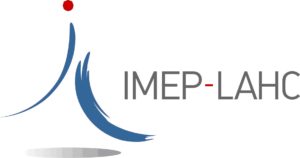Realization and optimization of biosensors based on SiC nanolines for DNA electrical detection
Published : 11 June 2018


PhD proposal 2018
Realization and optimization of biosensors based on SiC nanolines for DNA electrical detection
Scientific context :
The fast and direct detection of small quantities of biomolecules improves early medical diagnosis of certain serious diseases as cancers and can be used to detect in situ the presence of pathogenic viruses or GMOs for food industry, environmental protection and bio-defense. Currently, many research projects are conducted on nanoelectronic devices based on Si nanowires [1] that can perform such detection with very high sensitivity.
Indeed, SiC is already used for many biomedical applications covering prostheses and stents, biomimetic structures and cellular reconstruction. Very recently, it has emerged as the best candidate biocompatible semiconductor [2], which provides new integration prospects of in vivo sensors.
Objective of the research program :
Our research project aims to develop NWFETs (Nanowire Field Effect Transistors) based on SiC nanostructures for various applications: nanoelectronics in critical environments (temperature, gases, radiation) or nanosensor for temperature, gas or biological elements. This project fits in perfectly with one of the research department “Physics, Engineering and Materials” from University Grenoble Alpes (UGA), and in significant ongoing thematic programs at local, national and international level as Labex MINOS (Laboratory of Minatec Center on the Miniaturization of Innovative Nanoelectronics Devices), the IRT Nanoelectronics and Sinano Institute.
We have validated the concept of SiC nanowire transistors in previous phD thesis leading to a first demonstrator internationally [3, 4, 5]. Grafting and electrical detection of DNA through NWFET based on 2 types of innovative SiC nanostructures have been demonstrated [6, 7, 8, 9, 10]. In continuation of this work, this new phD thesis aims to develop biosensors based on eached nanolines and to optimize the properties and performances of this device in terms of sensitivity, detection limit, reversibility, stability, selectivity and acquisition time.
Workplan :
In this PhD project, the student will support the development of SiC nanolines, the realization of NWFET transistors, their functionalization towards the electrical detection of DNA. The work will be done within 2 Grenoble laboratory partners in this project: IMEP (Grenoble site of IMEP-LAHC) and LMGP.
The 4 main steps of the program are:
- Development of SiC nanolines by two methods:
– By ICP (Inductively Coupled Plasma) etching of nanolines into a SiC epitaxial layer of high quality and controlled doping (IMEP) [4].
– By ICP etching of nanolines into a Si film on SOI (Silicon On Insulator) following by a carburation of these Si nanolines in a dedicated reactor to the epitaxial growth CVD (Chemical Vapor Deposition) to obtain Si core / SiC shell nanolines (collaboration avec Univ. Parme et Univ South Florida).
Techniques such as atomic force microscopy AFM, transmission microscopy TEM, Raman spectroscopy and photoelectron spectroscopy XPS will be used for physical characterization and optimization of the resulting nanostructures (LMGP). - Technological achievement of NWFET:
Backgated nanodevices, based on these SiC nanostructures, will be carried out with the upstream facilities of the Advanced Technology Platform (PTA) in Minatec using deposition and etching techniques, and also advanced ebeam lithography and lift-off techniques for achieving optimized microcontacts (IMEP). - Functionalization and hybridization:
The covalent grafting of DNA probes on the two types of nanostructures will be realized in a localized manner by combining, on the one hand, an appropriated chemical functionalization process [7], and on the other hand, the electron beam lithography (LMGP) [8]. Electrical characterization of biosensors will be conducted on both technological variants and between each functionalization steps (IMEP). - Electrical detection of DNA: evaluation and performance optimization
After the electrical detection of hybridization molecules, experiments will focus on assessing and optimizing performance: study of the sensitivity, detection limit, selectivity, stability and reversibility.
Techniques such as current measurement (static and temporal), impedance, electrical noise, will be used on both variants of NWFETs (IMEP). Furthermore, the real-time acquisition will be studied and developed by the establishment of microfluidic systems (LMGP).
Références:
[1] N. Gao, W. Zhou, X. Jiang, G. Hong, T-M Fu, C.M. Lieber, “General Strategy for Biodetection in High Ionic Strength Solutions Using Transistor-Based Nanoelectronic Sensors”, Nano Letters. 15, p2143−2148 (2015)
[2] S.E.Saddow, Silicon Carbide Biotechnology: A Biocompatible Semiconductor for Advanced Biomedical Devices and Applications. Elsevier Sciences (2011)
[3] K. Rogdakis, thèse de l’Université de Grenoble (2010)
[4] J.H. Choi, thèse de l’Université de Grenoble (2013)
[5] M. Ollivier, thèse de l’Université de Grenoble (2013)
[6] L. Fradetal, thèse de l’Université de Grenoble (2014)
[7] L. Fradetal, V. Stambouli,, E. Bano, B. Pelissier, J.H. Choi, M. Ollivier, L. Latu-Romain, T. Boudou, I. Pignot-Paintrand, “Bio-Functionalization of Silicon Carbide Nanostructures for SiC Nanowire-Based Sensors Realization”; Journal of Nanoscience and Nanotechnology 14, 5, p3391–3397 (2014)
[8] J.H.Choi, L.Latu-Romain, E.Bano, F.Dhalluin, T.Chevolleau, T.Baron, ”Fabrication of SiC nanopillars by inductively coupled SF6/O2 plasma etching”, Journal of Physics D: Appl. Phys. 45 p235204 (2012)
[9] M. Ollivier, L. Latu-Romain, M. Martin, S. David, A. Mantoux, E. Bano, V. Soulière , G. Ferro, T. Baron, “Si–SiC core–shell nanowires”, J. Crystal Growth 363 p158-163 (2013)
[10] L. Fradetal, E. Bano, G. Attolini, F. Rossi, and V. Stambouli, “A Silicon Carbide nanowire field effect transistor for DNA detection”, Nanotechnology 27 (23) p235501 (2016)
Financial support :
The doctoral contract will be financed by University Grenoble Alpes in the framework of the Doctoral School EEATS.
Applications:
The candidate is Master of Sciences graduated in the field of Micro-Nanotechnology. An experience in cleanroom processing and device characterization would be a plus.
CV, marks of master (year1 and 2) and letter should be sent to supervisor and co –supervisor by June 10, 2018 for an application on June 12, 2018 :
Edwige BANO , IMEP- LAHC , edwige.bano@grenoble-inp.fr
Valérie STAMBOULI , LMGP , valerie.stambouli-sene@grenoble-inp.fr
If its application is approved, the candidate will have to registered in the Doctoral School EEATS :
https://www.adum.fr/as/ed/page.pl?site=edeeats



 Contact us
Contact us How to find us
How to find us









